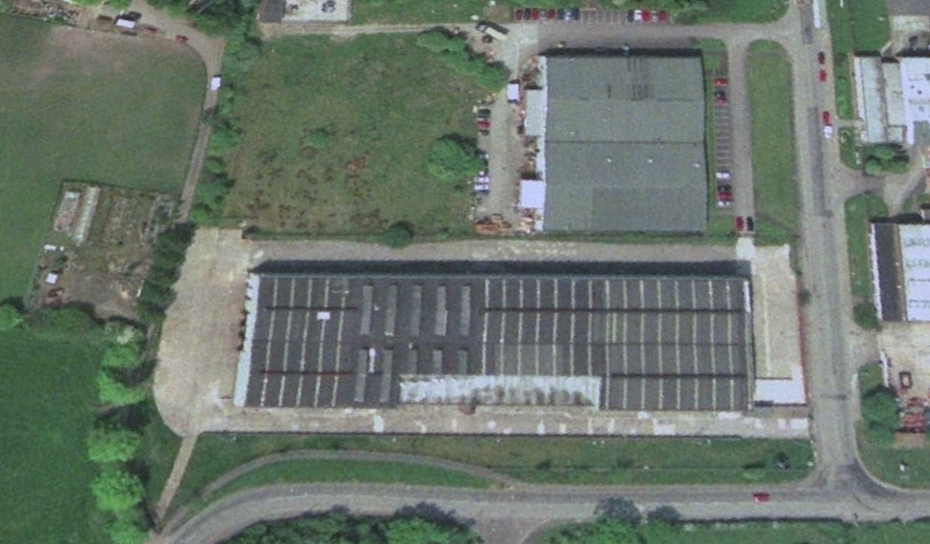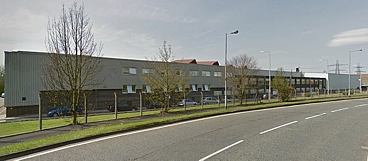|
|
|
Introduction
St. Helens was a relatively modern factory, having been established by the General Electric Company of England in 1968, as a purpose-built site for the manufacture of linear fluorescent lamps. It progressively took over this operation from the nearby Osram-GEC factory at Shaw. Despite the fact that the GEC made the world's first hot cathode fluorescent lamp and also discovered the important Halophosphate class of fluorescent materials, the company was not terribly efficient in the manufacture or commercialisation of fluorescent tubes. Following its takeover by Osram of Germany, the St. Helens factory was closed and thereafter, tubes were supplied from Osram's more efficient German and Italian fluorescent operations.
|
 Aerial View of the Factory and Warehouse, taken in 2000
Aerial View of the Factory and Warehouse, taken in 2000
|
| Address |
Lea Green Road, St. Helens, Merseyside, WA9 4QQ, United Kingdom. |
| Location |
53.4168°N, -2.7393°E. |
| Opened |
1968 |
| Closed |
c. 1990-95 |
| Products |
Linear Fluorescent Lamps |
Fluorescent Manufacturing
The original manufacturing of GEC fluorescent lamps was based at the company's works in Hammersmith, and after the second world war was relocated to Shaw to allow space for expansion of this rapidly growing lamp type. A third relocation became necessary in the late 1960s, when it was clear that the old vertical manufacturing processes at Shaw were being left too far behind competition and no longer able to compete. The vast strides forward that were being made by its key competitor, Thorn Lighting at Enfield, following its joint agreement with Sylvania of America which gave Thorn access to the latest high-speed-horizontal manufacturing technology, meant that GEC was losing a considerable share of the fluorescent market. New machinery was required to manufacture lamps more cost-effectively according to the horizontal process, and for optimum efficiency it was desirable to arrange the production in a straight line with one machine feeding directly into the next.
The available linear floor space as well as the architectural limitations of the old mills at Shaw must have presented considerable obstacles to the desires of the manufacturing engineers, and ultimately it was decided that a new site was necessary. The horizontal production machinery was designed in part by the Mechanical Development group at Wembley, and the build was contracted out to Badalex Automation - a company specialised in lampmaking machines. In 1968 GEC took ownership of a dedicated new line for making 4-foot 40W T12 tubes, and the new factory at St. Helens was erected specifically to house this new equipment.
For many years St. Helens only made the 4' 40W T12 types, and in 1975 this was operating at the rate of 40,000 tubes per week. At the same time it is reported that the factory was awaiting delivery of a second line, also from Badalex, which would allow it to extend its range to cover the longer 5' and 6' T12 tubes. The other tube lengths and diamaters were presumably at that time still being made at Shaw, but in later years, all fluorescent manufacturing was concentrated at St. Helens.
|
Development of Water-Based Coatings
Most fluorescent manufacturers around the world used to apply their phosphor coatings to the inside of the glass tube by making up a suspension of the powder in a solvent of butyl acetate. This offers particularly good adhesion properties and makes the coating process simple and easy to control. However in 1974 the price of butyl acetate rose very sharply, so much that it even threatened the continued production of fluorescent tubes. This triggered a number of development programmes around the world's lampmakers to search for cheaper solvents. The GEC's engineers focussed on the chepest of all, and during 1974-75 perfected the process of coating fluorescent lamps with water-based suspensions. The first Hydro-Based Coating went into production at St. Helens in 1975, and the economies it brought must have briefly put Osram-GEC into a relatively strong position - of course until competitors had also developed their own water-based coating processes.
|
Takeover by Osram of Germany
The history of the German Osram company is particularly complex, perhaps none more so than in the case of its British operations. The origins of Osram in England can be traced back to 1907, when Hugo Hirst of GEC desired to establish the first manufacturing of tungsten filament lamps in Britain. The technology for these lamps was developed on the continent, and in that year he set up a joint company with the Auer-Gesellschaft, one of the predecessors of the present-day Osram, to manufacture tungsten lamps at Hammersmith.
The operations prospered, but of course at the outset of the first world war, all enemy assets were confiscated. Osram lost its shareholding in the British operation as well as the rights to its brand name, a situation which was repeated in many other countries around the world. In 1916 Hirst had the opportunity to buy out this share from the Custodian of Enemy Property, and from that point onwards the company became entirely British-owned and Independent. Many years after the war Osram's parent company, Siemens, had rebuilt itself as a strong enterprise in Germany and was in a position to begin buying back many of its former overseas factories - only to have them confiscated for a second time at the outbreak of the second world war! This monumental setback for the company took many more years of slow growth from its home market to recover from, and the second buy-back operations did not begin until 1962 when Osram was able to recover its former brand and factories in France, followed steadily by many of its other overseas territories.
Years of intense negotiations followed between Osram and GEC, but the directors of GEC made it clear that they would not entertain any ideas of selling any share of their immensely profitable Lighting division back to Osram. Eventually in 1967 Osram came to the realisation that if it wanted to get back into the lighting market of Britain and its colonies around the globe, it was going to have to do so by building the business up again from scratch - and in competition against the formidable GEC. As such it formed the new company Wotan Lamps Ltd in Brtain and many other countries around the world - the change of name back to this old Siemens brand being necessary because it had lost its rights to the Osram trademark following the confiscations during the war.
As the years went on, and particularly in the decades following the leadership of the GEC under Sir Arnold Weinstock, the mentality did began to change, and GEC became more interested in other electrical avenues. It had been under-investing in lamps and losing market share to its rivals, Thorn Lighting and Philips, and it must have been becoming clear that the Osram-GEC lighting division was simply too small to compete in the increasingly globalised markets. A decision was reached on 19th March 1986 whereby Osram aquired 49% of Osram-GEC - and thereby regained control of its brand name in Britain and the remaining countries of the world, which it had lost an incredible 72 years earlier! So momentous was the occasion that a large rock was placed outside the company's headquarters in Munich, specially engraved to mark the historic re-acquisition of the last of its former divisions which had been lost following two world wars. The shareholding was increased to 100% in 1990, when GEC finally made the decision to exit the lighting business.
|
Operations under Osram GmbH
The new German owners were swift to integrate the British and other former GEC territories into their own operations, and the results of this proved to be disastrous for UK manufacturing. GEC had under-invested for many years in its lighting business, and in particular for incandescent and fluorescent manufacturing had fallen far behind its competitors, both elsewhere in Britain as well as internationally. The inevitable closure of the St. Helens fluorescent factory as well as the Wembley incandescent works was announced, and both were closed by the mid 1990s. The machinery from these sites was renovated by Crisp Engineering, a small spin-off company operating on the GEC Estate at Wembley, and exported to India. The old Badalex fluorescent equipment from St. Helens continues to be operated today at the factory of Surya Roshni in Kashipur, Uttaranchal province, in the North of India.
|
Photographs
|
 |
|
|
|
|
|
|
| Google StreetView, 2014 |
|
|
|
|
|
|
Examples of St. Helens Lamps
|
 |
|
|
|
|
|
|
|
|
|
|
| Bayonet Cap 5' 80W |
|
|
|
|
|
|
|
|
|
|
| 1 |
Light & Lighting 1975 Mar/Apr p.84 |
| 2 |
Private Communication, Graham Skeldon - Osram Wembley, 1995. |
|
|
|
|
|